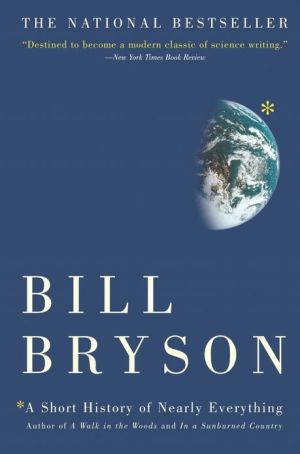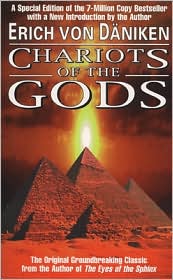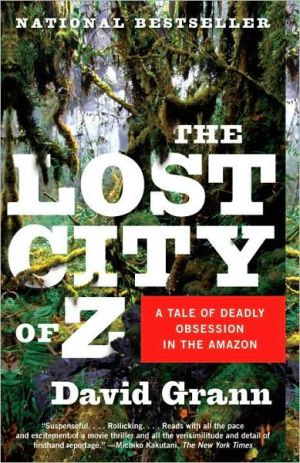A Short History of Nearly Everything
One of the world’s most beloved and bestselling writers takes his ultimate journey -- into the most intriguing and intractable questions that science seeks to answer.\ In A Walk in the Woods, Bill Bryson trekked the Appalachian Trail -- well, most of it. In In A Sunburned Country, he confronted some of the most lethal wildlife Australia has to offer. Now, in his biggest book, he confronts his greatest challenge: to understand -- and, if possible, answer -- the oldest, biggest questions we...
Search in google:
One of the world s most beloved and bestselling writers takes his ultimate journey -- into the most intriguing and intractable questions that science seeks to answer.In A Walk in the Woods, Bill Bryson trekked the Appalachian Trail -- well, most of it. In In A Sunburned Country, he confronted some of the most lethal wildlife Australia has to offer. Now, in his biggest book, he confronts his greatest challenge: to understand -- and, if possible, answer -- the oldest, biggest questions we have posed about the universe and ourselves. Taking as territory everything from the Big Bang to the rise of civilization, Bryson seeks to understand how we got from there being nothing at all to there being us. To that end, he has attached himself to a host of the world s most advanced (and often obsessed) archaeologists, anthropologists, and mathematicians, travelling to their offices, laboratories, and field camps. He has read (or tried to read) their books, pestered them with questions,... People Science with a smile.
1 HOW TO BUILD A UNIVERSE\ NO MATTER HOW hard you try you will never be able to grasp just how tiny, how spatially unassuming, is a proton. It is just way too small.\ A proton is an infinitesimal part of an atom, which is itself of course an insubstantial thing. Protons are so small that a little dib of ink like the dot on this i can hold something in the region of 500,000,000,000 of them, rather more than the number of seconds contained in half a million years. So protons are exceedingly microscopic, to say the very least.\ Now imagine if you can (and of course you can't) shrinking one of those protons down to a billionth of its normal size into a space so small that it would make a proton look enormous. Now pack into that tiny, tiny space about an ounce of matter. Excellent. You are ready to start a universe.\ I'm assuming of course that you wish to build an inflationary universe. If you'd prefer instead to build a more old-fashioned, standard Big Bang universe, you'll need additional materials. In fact, you will need to gather up everything there is--every last mote and particle of matter between here and the edge of creation--and squeeze it into a spot so infinitesimally compact that it has no dimensions at all. It is known as a singularity.\ In either case, get ready for a really big bang. Naturally, you will wish to retire to a safe place to observe the spectacle. Unfortunately, there is nowhere to retire to because outside the singularity there is no where. When the universe begins to expand, it won't be spreading out to fill a larger emptiness. The only space that exists is the space it creates as it goes.\ It is natural but wrong to visualize the singularity as a kind of pregnant dot hanging in a dark, boundless void. But there is no space, no darkness. The singularity has no "around" around it. There is no space for it to occupy, no place for it to be. We can't even ask how long it has been there--whether it has just lately popped into being, like a good idea, or whether it has been there forever, quietly awaiting the right moment. Time doesn't exist. There is no past for it to emerge from.\ And so, from nothing, our universe begins.\ In a single blinding pulse, a moment of glory much too swift and expansive for any form of words, the singularity assumes heavenly dimensions, space beyond conception. In the first lively second (a second that many cosmologists will devote careers to shaving into ever-finer wafers) is produced gravity and the other forces that govern physics. In less than a minute the universe is a million billion miles across and growing fast. There is a lot of heat now, ten billion degrees of it, enough to begin the nuclear reactions that create the lighter elements--principally hydrogen and helium, with a dash (about one atom in a hundred million) of lithium. In three minutes, 98 percent of all the matter there is or will ever be has been produced. We have a universe. It is a place of the most wondrous and gratifying possibility, and beautiful, too. And it was all done in about the time it takes to make a sandwich.\ When this moment happened is a matter of some debate. Cosmologists have long argued over whether the moment of creation was 10 billion years ago or twice that or something in between. The consensus seems to be heading for a figure of about 13.7 billion years, but these things are notoriously difficult to measure, as we shall see further on. All that can really be said is that at some indeterminate point in the very distant past, for reasons unknown, there came the moment known to science as t = 0. We were on our way.\ There is of course a great deal we don't know, and much of what we think we know we haven't known, or thought we've known, for long. Even the notion of the Big Bang is quite a recent one. The idea had been kicking around since the 1920s, when Georges Lem tre, a Belgian priest-scholar, first tentatively proposed it, but it didn't really become an active notion in cosmology until the mid-1960s when two young radio astronomers made an extraordinary and inadvertent discovery.\ Their names were Arno Penzias and Robert Wilson. In 1965, they were trying to make use of a large communications antenna owned by Bell Laboratories at Holmdel, New Jersey, but they were troubled by a persistent background noise--a steady, steamy hiss that made any experimental work impossible. The noise was unrelenting and unfocused. It came from every point in the sky, day and night, through every season. For a year the young astronomers did everything they could think of to track down and eliminate the noise. They tested every electrical system. They rebuilt instruments, checked circuits, wiggled wires, dusted plugs. They climbed into the dish and placed duct tape over every seam and rivet. They climbed back into the dish with brooms and scrubbing brushes and carefully swept it clean of what they referred to in a later paper as "white dielectric material," or what is known more commonly as bird shit. Nothing they tried worked.\ Unknown to them, just thirty miles away at Princeton University, a team of scientists led by Robert Dicke was working on how to find the very thing they were trying so diligently to get rid of. The Princeton researchers were pursuing an idea that had been suggested in the 1940s by the Russian-born astrophysicist George Gamow that if you looked deep enough into space you should find some cosmic background radiation left over from the Big Bang. Gamow calculated that by the time it crossed the vastness of the cosmos, the radiation would reach Earth in the form of microwaves. In a more recent paper he had even suggested an instrument that might do the job: the Bell antenna at Holmdel. Unfortunately, neither Penzias and Wilson, nor any of the Princeton team, had read Gamow's paper.\ The noise that Penzias and Wilson were hearing was, of course, the noise that Gamow had postulated. They had found the edge of the universe, or at least the visible part of it, 90 billion trillion miles away. They were "seeing" the first photons--the most ancient light in the universe--though time and distance had converted them to microwaves, just as Gamow had predicted. In his book The Inflationary Universe, Alan Guth provides an analogy that helps to put this finding in perspective. If you think of peering into the depths of the universe as like looking down from the hundredth floor of the Empire State Building (with the hundredth floor representing now and street level representing the moment of the Big Bang), at the time of Wilson and Penzias's discovery the most distant galaxies anyone had ever detected were on about the sixtieth floor, and the most distant things--quasars--were on about the twentieth. Penzias and Wilson's finding pushed our acquaintance with the visible universe to within half an inch of the sidewalk.\ Still unaware of what caused the noise, Wilson and Penzias phoned Dicke at Princeton and described their problem to him in the hope that he might suggest a solution. Dicke realized at once what the two young men had found. "Well, boys, we've just been scooped," he told his colleagues as he hung up the phone.\ Soon afterward the Astrophysical Journal published two articles: one by Penzias and Wilson describing their experience with the hiss, the other by Dicke's team explaining its nature. Although Penzias and Wilson had not been looking for cosmic background radiation, didn't know what it was when they had found it, and hadn't described or interpreted its character in any paper, they received the 1978 Nobel Prize in physics. The Princeton researchers got only sympathy. According to Dennis Overbye in Lonely Hearts of the Cosmos, neither Penzias nor Wilson altogether understood the significance of what they had found until they read about it in the New York Times.\ Incidentally, disturbance from cosmic background radiation is something we have all experienced. Tune your television to any channel it doesn't receive, and about 1 percent of the dancing static you see is accounted for by this ancient remnant of the Big Bang. The next time you complain that there is nothing on, remember that you can always watch the birth of the universe.\ Although everyone calls it the Big Bang, many books caution us not to think of it as an explosion in the conventional sense. It was, rather, a vast, sudden expansion on a whopping scale. So what caused it?\ One notion is that perhaps the singularity was the relic of an earlier, collapsed universe--that we're just one of an eternal cycle of expanding and collapsing universes, like the bladder on an oxygen machine. Others attribute the Big Bang to what they call "a false vacuum" or "a scalar field" or "vacuum energy"--some quality or thing, at any rate, that introduced a measure of instability into the nothingness that was. It seems impossible that you could get something from nothing, but the fact that once there was nothing and now there is a universe is evident proof that you can. It may be that our universe is merely part of many larger universes, some in different dimensions, and that Big Bangs are going on all the time all over the place. Or it may be that space and time had some other forms altogether before the Big Bang--forms too alien for us to imagine--and that the Big Bang represents some sort of transition phase, where the universe went from a form we can't understand to one we almost can. "These are very close to religious questions," Dr. Andrei Linde, a cosmologist at Stanford, told the New York Times in 2001.\ The Big Bang theory isn't about the bang itself but about what happened after the bang. Not long after, mind you. By doing a lot of math and watching carefully what goes on in particle accelerators, scientists believe they can look back to 10-43 seconds after the moment of creation, when the universe was still so small that you would have needed a microscope to find it. We mustn't swoon over every extraordinary number that comes before us, but it is perhaps worth latching on to one from time to time just to be reminded of their ungraspable and amazing breadth. Thus 10-43 is 0.0000000000000000000000000000000000000000001, or one 10 million trillion trillion trillionths of a second.\ Most of what we know, or believe we know, about the early moments of the universe is thanks to an idea called inflation theory first propounded in 1979 by a junior particle physicist, then at Stanford, now at MIT, named Alan Guth. He was thirty-two years old and, by his own admission, had never done anything much before. He would probably never have had his great theory except that he happened to attend a lecture on the Big Bang given by none other than Robert Dicke. The lecture inspired Guth to take an interest in cosmology, and in particular in the birth of the universe.\ The eventual result was the inflation theory, which holds that a fraction of a moment after the dawn of creation, the universe underwent a sudden dramatic expansion. It inflated--in effect ran away with itself, doubling in size every 10-34 seconds. The whole episode may have lasted no more than 10-30 seconds--that's one million million million million millionths of a second--but it changed the universe from something you could hold in your hand to something at least 10,000,000,000,000,000,000,000,000 times bigger. Inflation theory explains the ripples and eddies that make our universe possible. Without it, there would be no clumps of matter and thus no stars, just drifting gas and everlasting darkness.\ According to Guth's theory, at one ten-millionth of a trillionth of a trillionth of a trillionth of a second, gravity emerged. After another ludicrously brief interval it was joined by electromagnetism and the strong and weak nuclear forces--the stuff of physics. These were joined an instant later by swarms of elementary particles--the stuff of stuff. From nothing at all, suddenly there were swarms of photons, protons, electrons, neutrons, and much else--between 1079 and 1089 of each, according to the standard Big Bang theory.\ Such quantities are of course ungraspable. It is enough to know that in a single cracking instant we were endowed with a universe that was vast--at least a hundred billion light-years across, according to the theory, but possibly any size up to infinite--and perfectly arrayed for the creation of stars, galaxies, and other complex systems.\ What is extraordinary from our point of view is how well it turned out for us. If the universe had formed just a tiny bit differently--if gravity were fractionally stronger or weaker, if the expansion had proceeded just a little more slowly or swiftly--then there might never have been stable elements to make you and me and the ground we stand on. Had gravity been a trifle stronger, the universe itself might have collapsed like a badly erected tent, without precisely the right values to give it the right dimensions and density and component parts. Had it been weaker, however, nothing would have coalesced. The universe would have remained forever a dull, scattered void.\ This is one reason that some experts believe there may have been many other big bangs, perhaps trillions and trillions of them, spread through the mighty span of eternity, and that the reason we exist in this particular one is that this is one we could exist in. As Edward P. Tryon of Columbia University once put it: "In answer to the question of why it happened, I offer the modest proposal that our Universe is simply one of those things which happen from time to time." To which adds Guth: "Although the creation of a universe might be very unlikely, Tryon emphasized that no one had counted the failed attempts."\ Martin Rees, Britain's astronomer royal, believes that there are many universes, possibly an infinite number, each with different attributes, in different combinations, and that we simply live in one that combines things in the way that allows us to exist. He makes an analogy with a very large clothing store: "If there is a large stock of clothing, you're not surprised to find a suit that fits. If there are many universes, each governed by a differing set of numbers, there will be one where there is a particular set of numbers suitable to life. We are in that one."\ Rees maintains that six numbers in particular govern our universe, and that if any of these values were changed even very slightly things could not be as they are. For example, for the universe to exist as it does requires that hydrogen be converted to helium in a precise but comparatively stately manner--specifically, in a way that converts seven one-thousandths of its mass to energy. Lower that value very slightly--from 0.007 percent to 0.006 percent, say--and no transformation could take place: the universe would consist of hydrogen and nothing else. Raise the value very slightly--to 0.008 percent--and bonding would be so wildly prolific that the hydrogen would long since have been exhausted. In either case, with the slightest tweaking of the numbers the universe as we know and need it would not be here.\ From the Hardcover edition.
AcknowledgmentsIntroduction1Pt. ILost in the Cosmos71How to Build a Universe92Welcome to the Solar System193The Reverend Evans's Universe29Pt. IIThe Size of the Earth414The Measure of Things435The Stone-Breakers636Science Red in Tooth and Claw797Elemental Matters97Pt. IIIA New Age Dawns1138Einstein's Universe1159The Mighty Atom13310Getting the Lead Out14911Muster Mark's Quarks16112The Earth Moves173Pt. IVDangerous Planet18713Bang!18914The Fire Below20715Dangerous Beauty224Pt. VLife Itself23716Lonely Planet23917Into the Troposphere25518The Bounding Main27019The Rise of Life28720Small World30221Life Goes On32122Good-bye to All That33523The Richness of Being35024Cells37125Darwin's Singular Notion38126The Stuff of Life397Pt. VIThe Road to Us41727Ice Time41928The Mysterious Biped43429The Restless Ape45330Good-bye469Notes479Bibliography517Index529
\ From Barnes & NobleThis inviting young readers' edition compresses the 550-plus pages of Bill Bryson's 2004 A Short History of Nearly Everything into 176 pages of entertaining, digestible fact tidbits for brain-hungry kids. The topics span the universe, from the tiniest molecules to the primordial Big Bang to cavorting dinosaurs to the mysterious saltiness of the ocean. Stimulating stuff for kids who like to think.\ \ \ \ \ PeopleScience with a smile.\ \ \ The New York Times… the more I read of A Short History of Nearly Everything, the more I was convinced that Bryson had achieved exactly what he'd set out to do, and, moreover, that he'd done it in stylish, efficient, colloquial and stunningly accurate prose. We learn what the material world is like from the smallest quark to the largest galaxy and at all the levels in between. The basic facts of physics, chemistry, biology, botany, climatology, geology -- all these and many more are presented with exceptional clarity and skill. — Ed Regis\ \ \ \ \ Publishers WeeklyAs the title suggests, bestselling author Bryson (In a Sunburned Country) sets out to put his irrepressible stamp on all things under the sun. As he states at the outset, this is a book about life, the universe and everything, from the Big Bang to the ascendancy of Homo sapiens. "This is a book about how it happened," the author writes. "In particular how we went from there being nothing at all to there being something, and then how a little of that something turned into us, and also what happened in between and since." What follows is a brick of a volume summarizing moments both great and curious in the history of science, covering already well-trod territory in the fields of cosmology, astronomy, paleontology, geology, chemistry, physics and so on. Bryson relies on some of the best material in the history of science to have come out in recent years. This is great for Bryson fans, who can encounter this material in its barest essence with the bonus of having it served up in Bryson's distinctive voice. But readers in the field will already have studied this information more in-depth in the originals and may find themselves questioning the point of a breakneck tour of the sciences that contributes nothing novel. Nevertheless, to read Bryson is to travel with a memoirist gifted with wry observation and keen insight that shed new light on things we mistake for commonplace. To accompany the author as he travels with the likes of Charles Darwin on the Beagle, Albert Einstein or Isaac Newton is a trip worth taking for most readers. Copyright 2003 Reed Business Information.\ \ \ \ \ Library JournalWhile this book doesn't cover "nearly everything," it does a fantastic job of tackling certain topics: biology, earth science, chemistry, physics, and astronomy. Writing with wit and charm, Bryson, who has hiked the Appalachian Trail (A Walk in the Woods) and traveled around Australia (In a Sunburned Country), now takes us on a scientific odyssey from the Big Bang to the rise of civilization. Reflecting his gift for making science comprehensible yet fun, he tells the story of the discoveries and the people that have shaped our understanding of the universe. Along the way, we meet some fascinating and eccentric scientists. Although Bryson clearly intends this book for general readers, subject specialists will also enjoy his wry takes. The 30 chapters are divided among seven scientific topics, and this reviewer found himself reading chapters out of order, selecting topics of particular interest. There are useful footnotes, as well as chapter notes and a bibliography. Highly recommended for public and academic libraries. (Index not seen.) [Previewed in Prepub Alert, LJ 1/03.]-James Olson, Northeastern Illinois Univ. Lib, Chicago Copyright 2003 Reed Business Information.\ \ \ \ \ School Library JournalGr 5–9—An illustrated adaptation/abridgment of Bryson's A Short History of Nearly Everything, (Broadway, 2003), this treatment addresses the same set of sprawling questions as the original. Among them: How and when was the universe born and how vast might it now be? How old is the Earth and how much does it weigh? Why did the dawn of life happen to emerge here, of all places, and how could lowly microbes possibly be the primitive precursors of a species as complex as Homo sapiens? These are weighty questions for readers of any age to grapple with, but Bryson lightens the load by skillfully scaffolding the concepts he presents. Each topic is concisely addressed in the author's breezy Brit voice, explaining exactly what we know and how we came to know it. Photographs, cartoon sidebars, humorous anecdotes, and frequent recaps entertain and reinforce understanding along the journey. Ultimately, all of the ideas come together to give readers a wide-angle perspective on what a wildly improbable privilege it is to be a member of a species that the author says is "perhaps, the universe's supreme achievement." Bryson wraps up by suggesting that since we seem to be both "the best there is" and the only species capable of deciding our planet's future, we humans should redouble our efforts at being good stewards of the Earth. A highly recommended piece of popular science that succeeds largely because—as he nears age 60—there's clearly still a curious kid living in Bryson's head.—Jeffrey Hastings, Highlander Way Middle School, Howell, MI\ \ \ \ \ Kirkus ReviewsIn this abridged and illustrated version of his Short History of Nearly Everything (2003), Bryson invites a younger crowd of seekers on a tour of time, space and science-from the Big Bang and the birth of the solar system to the growth and study of life on Earth. The single-topic spreads are adorned with cartoon portraits of scientists, explorers and (frequently) the author himself, which go with small nature photos and the occasional chart or cutaway view. Though occasionally subject to sweeping and dubious statements-"There's no chance we could ever make a journey through the solar system"-Bryson makes a genial guide ("for you to be here now, trillions of drifting atoms had somehow to come together in a complicated and obliging manner to create you"), and readers with even a flicker of curiosity in their souls about Big Ideas will come away sharing his wonder at living in such a "fickle and eventful universe." (index) (Nonfiction. 11-13)\ \







